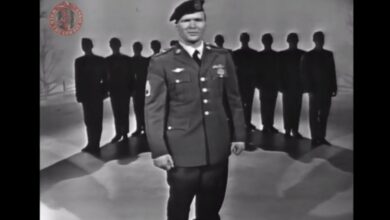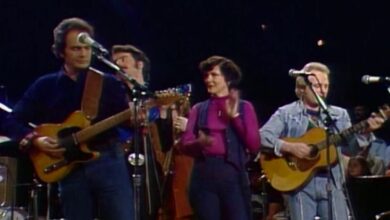Listening to Marty Haggard’s son sing his father’s song brings tears to our eyes
“Mama’s Hungry Eyes” is a song that profoundly captures the emotional landscape of familial love, sacrifice, and the struggles of motherhood. Written and recorded by Merle Haggard in 1968, the song showcases Haggard’s talent for storytelling, which was heavily influenced by his own life experiences. The lyrics are imbued with a sense of nostalgia and warmth, serving as a tribute to his mother, who faced tremendous hardships while raising her children alone after the premature death of her husband. The song’s narrative resonates with many who have navigated similar experiences, making it a poignant reflection on the universal struggles of motherhood.
In this heartfelt piece, Haggard paints a vivid picture of a mother’s longing and the emotional weight carried by those who strive to care for their families while enduring their own personal challenges. The imagery in the lyrics captures the intensity of a mother’s love and her relentless determination to provide for her children, even at the cost of her own well-being. Listeners can feel the raw emotion conveyed through each line, emphasizing themes of sacrifice, resilience, and the profound bond between mother and child.
The song’s melodic structure complements its lyrical depth, featuring simple yet powerful chords that allow the storytelling to take center stage. Haggard’s signature voice, deeply rooted in the traditions of country music, imbues the song with authenticity. His ability to convey emotion through vocal inflections and phrasing helps ensure that each word resonates with listeners, creating a lasting impression. The interplay of melody and lyrics fosters an atmosphere of empathy, inviting listeners to reflect on their own relationships and memories.
In addition to Haggard’s original version, the song has been revisited by other artists, including his son Marty Haggard. When Marty recorded his version of “Mama’s Hungry Eyes,” he honored the legacy of his father while adding new dimensions to the narrative. This fresh interpretation not only serves as a tribute to Haggard’s original work but also highlights the generational connection between father and son. Marty’s adaptation brings to the forefront the relentless spirit of their mother, depicting a variety of moments that detail the day-to-day realities faced by a working mother.
Marty’s rendition introduces additional lyrics that emphasize the sacrifices made by his mother, offering listeners a more intimate glimpse into her life. The imagery of a weary woman working hard at a truck stop, finding momentary joy in singing to uplift her children, adds a layer of depth to the narrative. This nuanced portrayal underscores the multifaceted nature of motherhood, revealing both the burdens and joys that coexist throughout the journey of raising a family. Such details allow audiences to connect more deeply with the story, fostering empathy and understanding for the experiences of mothers everywhere.
The emotional weight of “Mama’s Hungry Eyes” transcends the specific experiences of Haggard’s family, reaching audiences from various backgrounds and walks of life. The song addresses themes that are inherently relatable, such as love, struggle, and the lengths to which mothers go for their children. This universal resonance is a testament to the power of songwriting, showcasing the timeless relevance of personal narratives that reflect broader human truths.
Merle Haggard’s legacy is one rooted in authenticity and respect for the human condition. Born in 1937 in Bakersfield, California, Haggard’s life was marked by both hardship and triumph. He experienced early adversity that shaped his understanding of sacrifice and resilience, including time spent in juvenile detention. His background lent a rawness to his music that resonated with working-class listeners, and he became a key figure in the Bakersfield sound, a subgenre of country music characterized by its honky-tonk roots and straightforward storytelling. Throughout his prolific career, Haggard wrote and recorded numerous hits, solidifying his status as a cornerstone of American music history.
Haggard’s impact on the music industry extends beyond his own recordings; his influence can be seen in the work of countless artists who have drawn inspiration from his storytelling approach. His ability to weave personal experiences and reflections into his songs is a hallmark of his artistry, allowing listeners to engage with his music on a profound emotional level. By channeling his life into his work, Haggard created a legacy that speaks to the heart of American culture and the shared human experience.
Ultimately, “Mama’s Hungry Eyes” serves as a powerful tribute to the strength of mothers and the complexities of their sacrifices. The continued relevance of this song, along with its adaptations, highlights how music can capture and convey the essence of familial relationships. Both Merle and Marty Haggard’s contributions to the song reflect the enduring nature of love, memory, and the bonds that connect generations. As audiences continue to embrace these narratives, they find comfort in the shared experiences and emotional truths that are encapsulated within the song.
In essence, “Mama’s Hungry Eyes” remains a significant narrative within the realm of country music, celebrating not only the tenacity of mothers but also the interconnectedness of family stories that transcend time. The heartfelt portrayals offered by Merle and Marty Haggard exemplify how music can be a vessel for personal and collective storytelling, ensuring that the legacy of their experiences and the emotions entwined within them continue to echo through the years. This poignant tribute guarantees that “Mama’s Hungry Eyes” will be cherished and remembered as a vital piece of the country music tapestry, capturing the enduring spirit of maternal devotion and sacrifice.





